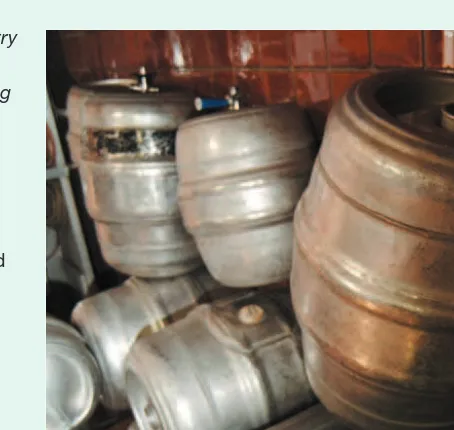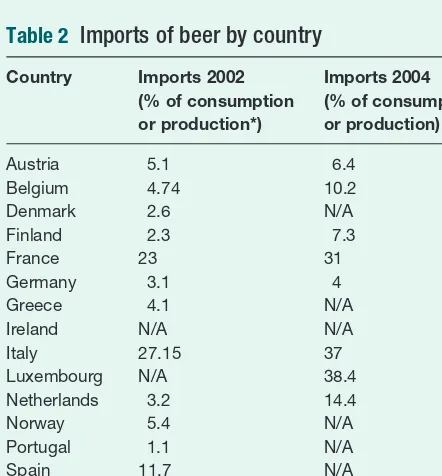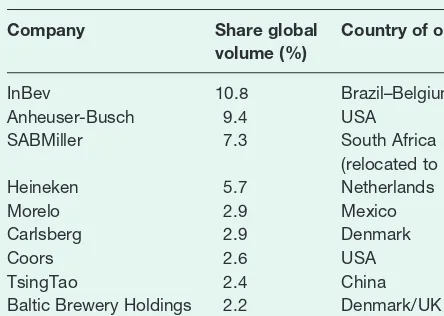This case is centred on the European brewing industry and examines how the increasingly competitive pressure of operating within global markets is causing consolidation through acquisitions, alliances and closures within the industry. This has resulted in the growth of the brewers’ reliance upon super brands.
In the first decade of the twenty-first century, European brewers faced a surprising paradox. The traditional centre of the beer industry worldwide, and still the largest regional market, Europe, was turning off beer. Beer consumption was falling in the largest markets of Germany and the United Kingdom, while burgeoning in emerging markets around the world. China, with 7 per cent annual growth, had become the largest single market by volume, while Brazilian volumes had overtaken Germany in 2005
(Euromonitor, 2006).
Table 1 details the overall decline of European beer consumption. Decline in traditional key markets is due to several factors. Governments are campaigning strongly against drunken driving, affecting the propensity to drink beer in restaurants, pubs and bars. There is increasing awareness of the effects of alcohol on health and fitness. Particularly In the United Kingdom, there is growing hostility towards so-called ‘binge drinking’, excessive alcohol consumption in pubs and clubs. Wines have also become increasingly popular in Northern European markets. However, beer consumption per capita varies widely between countries, being four times higher in Germany than in Italy, for example. Some traditionally low-consumption European markets have been showing good growth.
The drive against drunken driving and binge drinking has helped shift sales from the ‘on-trade’ (beer consumed on the premises, as in pubs or restaurants) to the off-trade (retail). Worldwide, the off-trade increased from 63 per cent of volume in 2000 to 66 per cent in 2005. The off-trade is increasingly dominated by large supermarket chains
such as Tesco or Carrefour, which often use cut-price offers on beer in order to lure people into their shops. More than one-fifth of beer volume is now sold through supermarkets. German retailers such as Aldi and Lidl have had considerable success with their own ‘private-label’ (rather than brewery-branded) beers. However, although on-trade volumes are falling in Europe, the sales values are rising, as brewers introduce higher-priced premium products such as extra-cold lagers or fruit-flavoured beers. On the other hand, a good deal of this increasing demand for premium products is being satisfied by the import of apparently exotic beers from overseas (see Table 2).
Brewers’ main purchasing costs are packaging (accounting for around half of non-labour costs), raw material such as barley, and energy. The European packaging industry is highly concentrated, dominated by international companies such as Crown in cans and Owens-Illinois in glass bottles. During 2006, Dutch brewer Heineken complained of an 11 per cent rise in packaging costs.
Global forces and the European brewing industry
Mike Blee and Richard Whittington89
G L O B A L F O R C E S A N D T H E E U R O P E A N B R E W I N G I N D U S T R Y
Acquisition, licensing and strategic alliances have all occurred as the leading brewers battle to control the market. There are global pressures for consolidation due to overcapacity within the industry, the need to contain costs and benefits of leveraging strong brands. For example, Belgian brewer Interbrew purchased parts of the old Bass Empire, Becks and Whitbread in 2001 and in 2004 announced a merger with Am Bev, the Brazilian brewery group, to create the largest brewer in the world, InBev. The second largest brewer, the American Anheuser-Busch, has been investing in China, Mexico and Europe. In 2002, South African Breweries acquired the Miller Group (USA) and Pilsner Urquell in the Czech Republic, becoming SABMiller. Smaller players in fast-growing Chinese and South American markets are being snapped up by the large international brewers too. Medium-sized Australian brewer Fosters is withdrawing from direct participation in many international markets, for example selling its European brand-rights to Scottish & Newcastle. Table 3 lists the world’s top 10 brewing companies, which accounted for around half of world beer volumes. There remain many small specialist and regional
Table 2
Imports of beer by country
Country Imports 2002 Imports 2004 (% of consumption (% of consumption or production*) or production)
Austria 5.1 6.4
* Import figures do not include beers brewed under licence in home country; countries vary in measuring % of production or consumption.
Source: www.brewersofeurope.org.
Table 1
European beer consumption by country and year (000 hectolitres)
Country 1980 2000 2001 2002 2003 2004 2005
Austria 7651 8762 8627 8734 8979 8881 8970
Belgium 12945 10064 9986 9901 9935 9703 N/A
Denmark 6698 5452 5282 5202 5181 4862 N/A
Finland 2738 4024 4085 4136 4179 4370 N/A
France 23745 21420 21331 20629 21168 20200 N/A
Germany† 89820 103105 100904 100385 97107 95639 94994
Greece N/A 4288 4181 4247 3905 N/A N/A
Ireland 4174 5594 5625 5536 5315 5206 N/A
Italy 9539 16289 16694 16340 17452 17194 17340
Luxembourg 417 472 445 440 373 N/A N/A
Netherlands 12213 13129 12922 11985 12771 12687 12747
Norway* 7651 2327 2290 2420 2270 2490 N/A
Portugal 3534 6453 6276 5948 6008 6266 6224
Spain 20065 29151 31126 30715 33451 N/A N/A
Sweden 3935 5011 4932 4998 4969 4635 4566
Switzerland* 4433 4194 4141 4127 4334 4262 N/A
UK 65490 57007 58234 59384 60302 59195 N/A
* Non-EU countries; †1980 excludes GDR. Figures adjusted.
brewers, such as the Dutch company Grolsch (see below) or the British Cobra Beer, originating in the Indian restaurant market.
Four brewing companies
Heineken (The Netherlands)
Heineken is the biggest of the European brewery businesses, and has three-quarters of its sales in the region. Total sales in 2006 were A11.8bn (£8bn). About 5 per cent of sales are in Asia–Pacific and 17 per cent of sales are in the Americas. The company’s biggest brands are Heineken itself and Amstel. The company remains a family-controlled business, which it claims gives it the stability and independence to pursue steady growth internationally.
Heineken’s strategy overseas is to use locally acquired companies as a means of introducing the Heineken brand to new markets. It aims to strengthen local companies by transferring expertise and
technology. The result is to create economies of scale for both the local beers and Heineken. Heineken’s four priorities for action are to accelerate revenue growth, to improve efficiency and cost reduction, to speed up strategy implementation and to focus on those markets where the company believes it can win.
Grolsch (The Netherlands)
Royal Grolsch NV is a medium-size international brewing group, established in 1615. With overall
sales in 2005 of A313m, it is less than a twentieth of the size of Heineken. Its key products include Grolsch premium lager and new flavoured beers (Grolsch lemon and Grolsch pink grapefruit). In The Netherlands Grolsch holds the rights for the sale and distribution of the valued US Miller brand. About half its sales are obtained overseas, either through export or licensing of production: the United Kingdom is its second largest market. In 2005, Grolsch centralised its own production on a single new Dutch brewery to increase efficiency and volume, and opened a small additional ‘trial’ brewery in order to support innovation.
Innovation and branding are core to the company’s strategy. The company believes that its strong and distinctive beers can succeed in a market of increased homogenisation. Its brand is reinforced by its striking green bottles and its unique swing-tops.
InBev (Belgium /Brazil)
InBev was created in 2004 from the merger of Belgian InterBrew and Brazilian AmBev. With a turnover of A13.3bn in 2006, it is the largest brewer in the world,
holding number one or number two positions in 20 different countries. Its well-known international brands include Beck’s and Stella Artois. Through a series of acquisitions, InBev has become the second largest brewer in China.
The company is frank about its strategy: to transform itself from the biggest brewing company in the world to the best. It aims to do this by building strong global brands and increasing efficiency. Efficiency gains will come from more central coordination of purchasing, including media and IT; from the optimisation of its inherited network of breweries; and from the sharing of best practice across sites internationally. Although acquisitions continue, InBev is now emphasising organic growth and improved margins from its existing businesses.
Scottish and Newcastle ( UK )
Scottish and Newcastle is a European-focused brewing group based in Edinburgh. In 2005, its turnover was £3.9bn (A5.5bn). Its key brands include John Smiths, Kronenbourg, Kanterbrau, Baltika and (in Europe) Fosters. It is the fourth largest brewer in Europe in volume terms, and market leader in the UK, France and Russia. The company has made many
Table 3
The world’s top 10 brewery companies by
volume: 2005
Company Share global Country of origin volume (%)
InBev 10.8 Brazil–Belgium
Anheuser-Busch 9.4 USA
SABMiller 7.3 South Africa
(relocated to UK )
Heineken 5.7 Netherlands
Morelo 2.9 Mexico
Carlsberg 2.9 Denmark
Coors 2.6 USA
TsingTao 2.4 China
Baltic Brewery Holdings 2.2 Denmark/UK
Asahi 2.1 Japan
91
G L O B A L F O R C E S A N D T H E E U R O P E A N B R E W I N G I N D U S T R Y
acquisitions in the UK (including Bulmer’s cider), France, Greece and Finland. The group’s 50 per cent investment in Baltic Beverages has given it exposure to the fast-growing markets of Russia, Ukraine and the Baltic countries. In China, Scottish and Newcastle has a 20 per cent stake in CBC, the country’s fifth largest brewery. In India, the company’s United Breweries is the country’s largest brewer, with the Kingfisher brand. In the USA, Scottish and Newcastle is the second largest importer of foreign beers. The company emphasises the development of innovative and premium beers, and is closing down its more inefficient breweries.
Questions
1 Using the data from the case (and any other sources available), carry out for the European brewing industry (i) a PESTEL analysis and (ii) a five forces analysis. What do you conclude?
2 For the four breweries outlined above (or breweries of your own choice) explain: (a) how these trends will impact differently on
these different companies; and
Strategic Capability
3
The Strategic
Position


